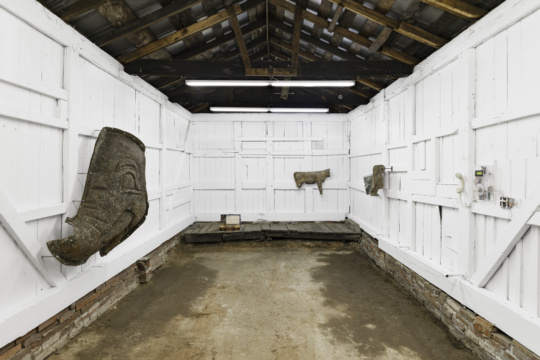
Visual art could arguably be seen solely as a journey and exploration of identity. Whether experienced as an epiphanic blast or a cumulative gain of insight, this ongoing exploration of self is something that artists are surely guided, defined, or even misled by. Categorization, criticism, and commercial viability can become flashpoints both narrowing and widening the path. But for some artists, the randomly delivered, yet undeniable element of ethnicity and skin color can materialize into an unwarranted detour of race-specific labeling, prejudice, and arduous impasses.
Three notable northeast Florida artists are presenting a panel discussion, “The State of Black Art/What is Black Art?,” to share their own experiences on ethnicity and creativity. Overstreet Ducasse and Princess Simpson Rashid will present the talk on June 30 with moderator Dustin Harewood, professor of art at Florida State College at Jacksonville.

The discussion is part of an ongoing series of events that have been presented in conjunction with the exhibition “Through Our Eyes 2015: Wouldn’t Take Nothing for My Journey (An Artistic Revolution),” on view through July 28 at the Ritz Theatre & Museum. Now in its 23rd year, “Through Our Eyes” is a much-anticipated annual exhibition highlighting both emerging and established African-American artists in the area.
In 2013, Ducasse, Harewood, and Rashid collaborated on the group show “The All Americans,” which addressed the three painters’ views on race and art. “In a way, this artist talk is an extension of that—the question of what defines an artist of color,” explains Rashid. “Is it the narrative behind their work or is it simply the color of their skin?”
While the trio is close friends and contemporaries, distinct narratives and styles fuel their respective work. Ducasse is known for his intensely agitprop pieces, as well as more metaphysical works. His ongoing Target Series both celebrates and eviscerates various heroic or repellent people. Rashid is an adept abstractionist, skilled at restraining and guiding planes of color and texture to touch on the historical and personal, including her study of both music and abstract mathematics. “I think all of that allowed me to see a connection between these disciplines,” says Rashid. “Painting abstractly allows me to explore that connection most effectively.” While some of Harewood’s works are convex, 3-D pieces that push outward towards the viewer, his art most definitely stands squarely in the center of contemporary painting, as gridlike patterns are populated with Gerhard Richter-style color slashes alongside video game icons.

While “Through Our Eyes” features African-American art, and the discussion’s topic is “black art,” the artists’ heritage is as varied as their paintings. Ducasse was born in Haiti and Harewood is first generation Barbadian-American. “When people ask I usually say that I am West Indian. I don’t mind at all being referred to as African-American, especially since I was born here,” says Harewood. “However, many of my family’s traditions are different from African-Americans’.
Rashid expands upon these semantics surrounding skin tone, identity, and erasing creative boundaries. “Dustin, Overstreet, and I all have dark skin complexions but we also have a completely different American experience. My family’s American experience is predominantly based in the South. Overstreet is from Haiti. Dustin’s family is from Barbados. So they come to the conversation from an immigrant experience as well as a product of slavery. In regards to art, the conversation is all the more relevant in the sense that art tends to also categorize people—and we find those categories inadequate.”

Harewood’s views on category and color are surely informed by his earliest days on his creative path. “I have mixed feelings about the term ‘black art.’ It was always my goal to avoid being labeled as a ‘black artist.’ I find the term extremely limiting,” says Harewood. “Back in school, I remember having to study the importance of the Abstract Expressionist movement. We went in depth on the lives of Pollock and Krasner. Somewhere toward the end of the course, I asked my professor, ‘What about the Harlem Renaissance? Wasn’t it going on around the same time as all of this other stuff?’ He grew silent, thought about it for a while, and said that he was sorry that he didn’t have any information on what was happening in Harlem. I really looked up to my professor, so that moment has always stayed with me. Needless to say, I was extremely disappointed at the fact that anything labeled ‘black art,’ was considered more of a novelty, something not to be taken too seriously. Of course, no one would ever come out and say that it wasn’t taken seriously, but I think that anyone could put two and two together.”
The State of Black Art/What is Black Art? will take place on Tuesday, June 30, 6-8pm, at the Ritz Theatre & Museum, 829 N. Davis Street, Jacksonville.
“Through Our Eyes 2015: Wouldn’t Take Nothing for My Journey (An Artistic Revolution),” featuring works by 20 African-American artists in the northeast Florida region, is on view through July 28.
The State of Black Art / What is Black Art?, in Jacksonville
Daniel A. Brown is a musician and writer based in Jacksonville Beach. A onetime bassist for Royal Trux and ’68 Comeback, Brown is also the arts and entertainment editor for Folio Weekly. He maintains a visual arts site called STAREHOUSE (starehouse.com), which profiles Northeast Florida, national, and international artists.
Related Stories
Mood Ring
Reviews
Reviews
How To Get Free
Pieced together through collage, video capture, and a spoken poem, artist Kay-Ann Henry presents the intricacies of Afro-religious practices and Jamaica's particular expression of obeah, pocomania, and kumina.
As for me, I’m just passing through this planet at Bad Water, Knoxville
Harrison Wayne reviews the entangled sculptures and taxidermic specimens found in As for me, I’m just passing through this planet at Bad Water, Knoxville.
Mapping the Body at FotoFest’s 2024 Biennial, Houston
Rosa Boshier González explores how three artists on view during FotoFest's 2024 Biennial in Houston have mapped histories of movement onto the body.




